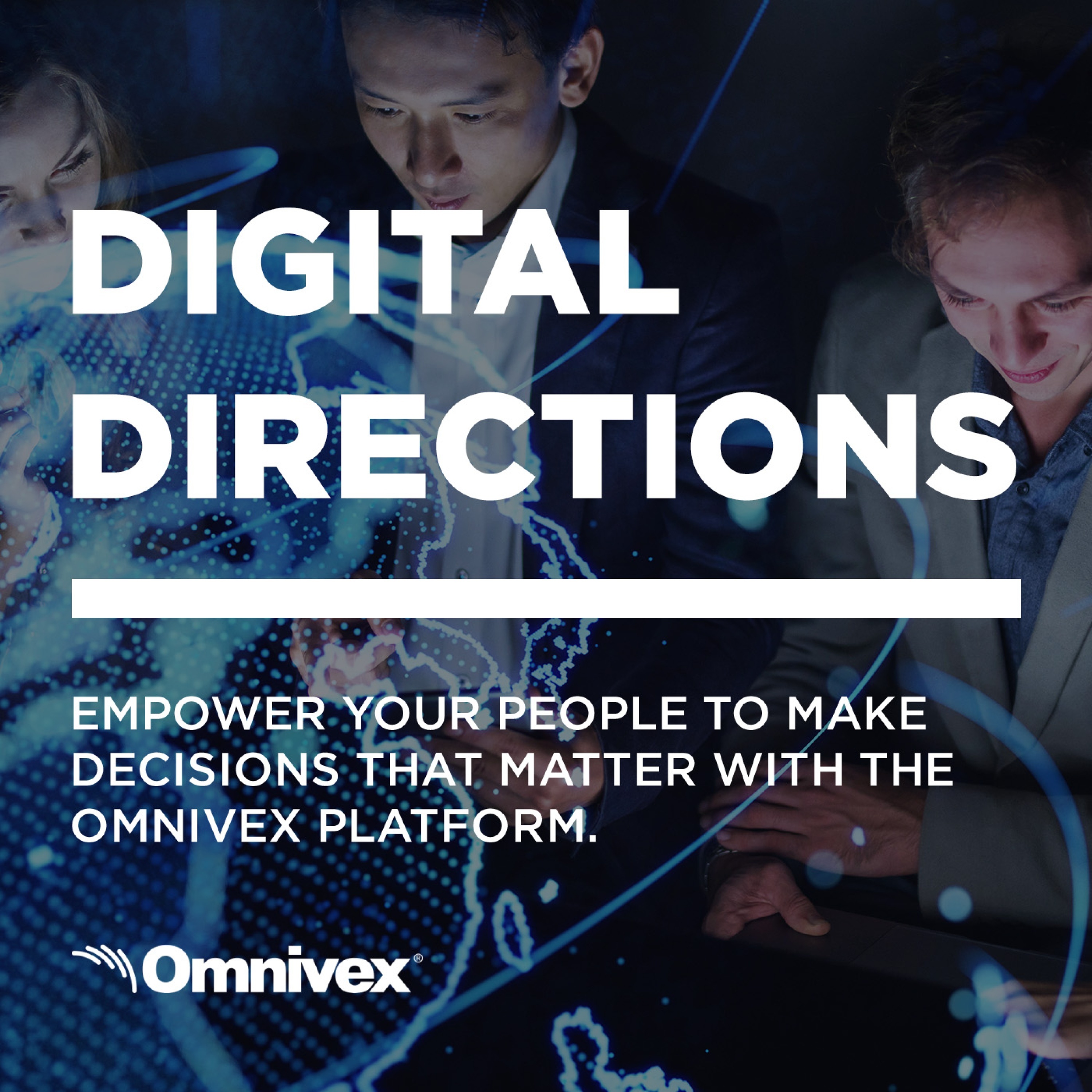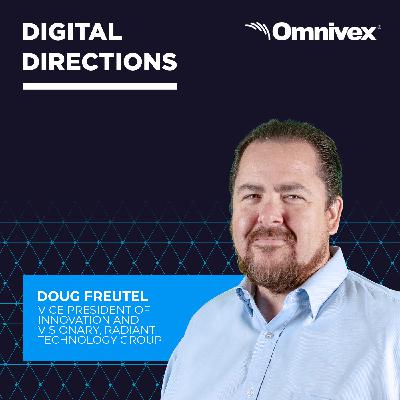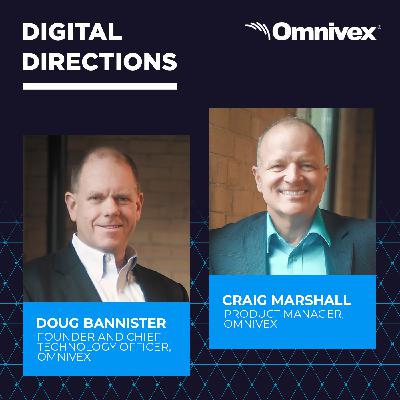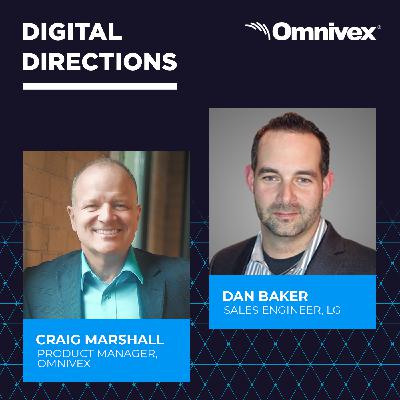Discover Digital Directions by Omnivex
Digital Directions by Omnivex

Digital Directions by Omnivex
Author: Omnivex
Subscribed: 0Played: 0Subscribe
Share
© 2021
Description
Welcome to Digital Directions, a podcast from Omnivex, where we we've been at the forefront of digital communications for over 30 years. We believe information is meant to be used and digital communications are an organization's first line of offense in a rapidly changing world.
11 Episodes
Reverse
Experiential design and digital signage work well together. Before the advent of digital signage, designing experiences was much more static. Digital signage takes it to a new level. But how?To answer the question, Digital Directions host Tyler Kern spoke with Rich Archer, Creative Lead at Omnivex Corporation. Archer has been in the creative field for over 20 years, helping brands tell their stories boldly.To kick off, Archer defined experiential design. “It’s a broad term, but it’s designing an experience. As a designer, our training is to design with the user in mind and to do so with a purpose. We’re shaping the experience of the end-user, and you can put everything about your brand into this environment.”Employing digital signage in these settings just makes sense because of its inherent benefits. “You can change content, use video and graphics, and schedule content at different times. It naturally helps you design a better experience,” Archer said.Archer noted that the many applications of digital signage, including wayfinding and interactive kiosks, all improve that audience’s experience. To illustrate it with real-world applications, Archer offered three great examples. “First is the Disney Store and all its interactive screens. Another is the San Francisco airport, which has a video kiosk with local artists, and you can make a playlist of videos.”These two occurred in the brand’s space, but the last example goes outside the four walls. “McDonald’s celebrated the Big Mac anniversary by putting in digital signage billboards with cameras at bus stops, asking consumers to enter the Big Mac Dance Challenge. It’s like an interactive ad.”
Technologist, futurist, and digital Renaissance man Doug Bannister discusses the technology disruptions that changed industries, altered futures, and how people can spot these trends before they happen.
Doug Freutel, Vice President of Innovation and Visionary, Radiant Technology Group, returned to Digital Directions to complete his conversation on digital signage as a way to help facilitate flexible workspaces.Fruetel picked things up where he left off, discussing the evolving workspaces of the future – one where work hubs may become the norm.“How do we maintain capacity on how many people can come back?,” Freutel said while discussing the future workspace. “You have that 40-45% of workers that want that hybrid situation. We don’t need full-time desks for those people. But, when people come back, they want to be able to have those social engagements. So, if you split your group into two, and someone on team A, which is working Mondays and Wednesdays, wants to engage in person with somebody who’s working on Tuesdays and Thursdays, you’re eliminating that opportunity.”
There are many avenues to pursue related to the future workspaces and how the pandemic has forever changed the landscape of the way people work.Doug Freutel, Vice President of Innovation and Visionary, Radiant Technology Group, offered up his perspective and insights on how digital innovations, specifically digital signage, will play a role in these future workspaces.Freutel kicked off the first of this two-part discussion with some of the new business workplace challenges of the pandemic.
2020 is a year like no other, and the same goes for the year that’s been in the technology space. To break down some of the big topics and trends in technology today, Omnivex’s Founder and Chief Technology Officer, Doug Bannister, teamed up with Omnivex Product Manager Craig Marshall. They shared their experience and thoughts with host Tyler Kern.5G is a word people hear touted as the next revolution in telecom. But do the hype and expectations match the reality?“One of the things that makes 5G different than 4G,” Bannister said, “is they’re changing the frequency at which they transmit information. It’s going to a much higher frequency. The advantage of that is at a higher frequency, you can get much higher data transmission.”The downside?“At these higher frequencies, the transmission distance drops, and that is an issue that providers will need to tackle so 5G can reach its full potential.”QR codes are not new, and, to many, they seemed never to take off. But with upgrades in technology and most smartphone cameras now equipped to read QR codes without a separate reader app, QR codes are finding new life, especially during the pandemic.“In response to COVID, most venues are rethinking how to manage crowds and people,” Marshall said. “So, having the ability to provide information to people’s phones to avoid crowding around information is desirable. People are also more reticent to touching a kiosk in a public area.”Restaurants are also tapping into the benefits of QR codes as an alternative to touching menus.Remote work is something not everyone before the pandemic could relate to, but it’s now the new normal for many, and it looks as if it is here to stay for many businesses. Technology made remote work possible, and a lot of innovations have come as a result.“I think the technology was in place to facilitate this,” Marshall said, “it was just a matter of allowing people to access it. But, certainly, the collaborative tools out there have grown in popularity, and you’ll see greater advances in those.”
It’s always been important for people to know where they should be going, but with the coronavirus pandemic turning how people are gathering or clustering into a matter of public health, it’s never been more critical.
One of the best ways to keep people safe is to make sure there’s messaging letting people know things like how long a line is or how many people are in a certain area or displaying regulations about social distancing, masking or direction of traffic in a space.
That requires both a hardware solution and a software solution, which is why Dan Baker, Sales Engineer at LG, and Craig Marshall, Product Manager at Omnivex, have teamed up to provide solutions for businesses looking at digital signage during the pandemic.
Those solutions can go far beyond simply putting up a monitor and showing a static message, Baker said, pointing out a place like a hotel check-in desk, where you want to both provide hospitality but keep a safe distance between guest and desk clerk.
“One real nice solution that LG has now is our transparent OLED display,” Baker said. “That really can be a nice way to interact with someone. Put their information on a screen that’s see-through, and you can see the person on the other side and interact with them that way. So, you’re kind of getting a shield and display in one and not only protecting yourself but heightening your customers’ experience.”
While digital signage is critical during the pandemic, it’s also a strong long-term investment for either improving the look and function of a retail outlet or serving a different purpose in the office.
“If you did go ahead and implement a bunch of digital communications for this purpose, you’re going to wind up using this stuff for all sorts of other things, whether it’s tracking key performance indicators of your business, acknowledging real-time successes and wins, or having virtual huddles and letting people know what’s going on in the businesses,” Marshall said. “Everyone is just more connected, more engaged. Communications are the silver bullet, and this is just going to carry on.”
Doug Bannister, Founder and Chief Technology Officer of Omnivex Corporation, has seen his fair share of business-altering events in the near 30 years his company’s been in business. But Bannister admits he’s experienced nothing quite like the ongoing pandemic that’s changed the way every company does business. In this time of COVID-19, what does the new normal even look like?
“If this event took place 10 years ago, technology was nowhere near where it is now,” Bannister said.
Many of the web conferencing tools people are using to communicate now were not available even five years ago. And Bannister pointed out everything from grocery orders to movie watching is under a rapid change where people are doing more things online, and through apps, that they previously did in person. Online education tools are another area that is transforming as the pandemic goes on.
During this time of rapidly changing events and information, Bannister said the most important thing for businesses to do is to provide reliable, consistent, and continual communication with their workers and their customers.
“All of these people in business now working remotely have put a magnifying glass on areas we never really focused on before,” Bannister said.
It is crucial to re-examine how we communicate under these new sets of circumstances.
If there is a silver lining to all of this, Bannister believes live-altering global events such as the current pandemic bring forth technological enhancements and behavioral changes that transform the way business moves forward. The new normal may be in flux, but one thing’s for sure: humans are adaptable and will make the change.
Doug Bannister, Founder and Chief Technology Officer of Omnivex Corporation, started his company in 1991. There’s been a considerable transformation of technology in those near 30 years, and Bannister’s got a great handle on looking down the road, assessing the future of technology and determining which technologies work and which ones don’t.
Host Tyler Kern sat down with Bannister to explore some emerging digital communication technologies that have people excited.
A few hot topics Bannister dove into were blockchain, machine learning, Artificial intelligence, IoT and edge computing. With blockchain, companies are partnering together to put health records online using this secure method. Kern noted there is a lot of misunderstanding about the differences between blockchain and bitcoin.
“The same way email is an application, and the internet is the underlying technology, so too is the relationship between bitcoin and blockchain,” Bannister said. “Bitcoin is the application, and blockchain is the underlying technology that makes it possible.”
What about artificial intelligence (AI) and machine learning? Are these two interchangeable terms? Bannister believes they’re two distinct things.
Artificial intelligence is the technology that makes machines look like they’re doing something and appearing smart, while machine learning, algorithms and systems improve machine performance over time with experience. Bannister said machine learning capabilities get pretty advanced.
With the internet of things, or IoT, Bannister said people might think of IoT as controlling a light switch or thermostat, but it is much more.
“IoT can control your environment, but it can also collect information from your environment.”
A great example is today’s sensor-filled automobiles that provide essential data to both the owner of the car and the manufacturer who can use this data to improve future vehicles and quickly run diagnostics when something isn’t working in the car.
For the latest news, videos and podcasts in the Software and Technology Industry, be sure to subscribe to our industry publication.
“Digital transformation” is on the tip of everyone’s tongue as the technology revolution continues to change society at large. So what does this buzzword mean? Guest Chris Devlin, president of Omnivex, unpacks and defines the jargon for listeners on Marketscale’s Pro AV podcast, explaining how the concept benefits businesses as well as consumers. To explain the holistic idea of digital transformation, Devlin quotes MIT researcher, George Wesman. “Digital transformation is a radical rethinking of how an organization uses technology, people, and process to fundamentally change business performance," he said. Hospitals, airports, malls, restaurants, and major corporations are all undergoing digital transformations on complex levels. The biggest change is the merging and collaboration between departments as digital transformation filters throughout an agency. Devlin emphasizes this by pointing out how boards of directors are in desperate need of IT experts to oversee the digital big picture. In a fast-paced world, Devlin argues that the beauty of digital really shines, allowing for adaptability, flexibility, and the agility to control a message in real-time, such as during an emergency or crisis. Ultimately, Devlin said, digital signage and communication is about improving revenue, safety, and cost, for everyone. When organizations are proactive with public and employee communication, it shows in profits, popular perception, and customer engagement.
Designing today's digital signage is more than thinking about filling the screen. It's about the how and why of the information and data being presented. (And actually, don't fill the screen. White space is your friend.)
Today on the Pro AV Podcast, host Shelby Skrhak sat down with digital designer Rich Archer for a nuts and bolts discussion about the philosophy of design and how data makes the difference in effective and good-looking digital signage.
Archer joined the design team at Omnivex three years ago, after spending two decades in design, marketing, and communications. With an educational background in architecture and experience in graphic design, Archer saw an interesting intersection of two schools of design thought coming together in digital signage.
"I don't think I could find a better merge of data and design than digital signage with the applications of it we build here at Omnivex," Archer said.
Archer uses this blend to influence his design approach and offers tips for doing the same.
"Thinking of the how and why of graphic design was just like thinking of the how and why of architecture for me," Archer said. "Thinking about the how and why we build houses for certain scenarios, clients, climates... that applies here."
Pro AV professionals possess unique circumstances in today's market due to their de facto dual-role as both technical innovators and creative directors. While certain experience-driven industries stress an emphasis on exciting technology and visuals, Pro AV professionals are finding their own piece of the experience economy is coming in elevating content and storytelling.
Rich Archer, digital designer at Omnivex, believes a product is equally as important as the manner in which it is displayed.
"Content is still king," he said. "No matter what the size, shape – no matter the technology - your display is only as effective as the content that's on it."
Archer said digital signage has surpassed websites and print signage as the most effective form of advertising thanks in part to live customer feedback.
"The audio-visual is important, but there's a technical side to it that's necessary…especially with live information that's being pulled from the internet."
In terms of brand experience, Archer cited a glass walkway in China that appeared to break when walked upon as a prime example of the impact of live digital signage. He said the ideal visual display leaves the customer with something to remember.
"Create something that people are never going to forget," he said. "Making it memorable like that and actually engaging your customers is one of the keys to having success."
Archer said the creative side will undoubtedly continue to push the technology forward as it becomes widespread.
"I live in downtown Toronto," he said. "Every store has something you can interact with."












